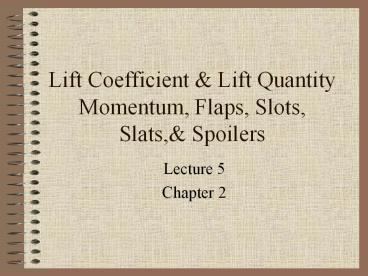Lift Coefficient - PowerPoint PPT Presentation
Title:
Lift Coefficient
Description:
... through some angle from the original chord position to yield a higher camber. ... Notice the effective chordline increase because the camber is increased. ... – PowerPoint PPT presentation
Number of Views:227
Avg rating:3.0/5.0
Title: Lift Coefficient
1
Lift Coefficient Lift QuantityMomentum, Flaps,
Slots, Slats, Spoilers
- Lecture 5
- Chapter 2
2
Lift Coefficient Lift Quantity
- Force pressure x area
- The amount of lift obtained from a wing should be
proportional to the dynamic pressure of the wing
area. - The lift coefficient measures the portion of lift
of the resulting force being transformed.
3
Example
- If a rectangular wing can be bounded by a wall in
a wind tunnel, it essentially has no tips, and
simulates a section of an infinite wing. - Measuring the lift in this manner the dividing it
by the dynamic pressure and wing area yields the
lift coefficient associated with the airfoil.
4
Example continued
- There is no span effect because there is no tip
to form a vortex and induce downwash. - This is how airfoil data can be collected in wind
tunnels. - Plotting lift coefficients versus angle of attack
to determine lift properties of airfoils.
5
Figures 2-43 2-44
- CL V. (0) Lift coefficient versus angle of
attack for typical curve of a wingFigure 2-43 - C1 V. lt - Lift coefficient versus stall for a
typical airfoil section - C wing lift coefficient
- c coefficient of airfoils section
6
Momentum
- Momentum is a physical quantity defined as mass
times velocity. - A mass of air moving at a certain speed has
momentum. - When momentum changes a force is exerted and is
expressed as the rate of momentum change.
7
Flaps
- The flap is the moveable portion of the airfoil
that is deflected through some angle from the
original chord position to yield a higher camber. - Page 49 figure 2-46 shows the trailing edge in
the normal position and the extended position. - Notice the effective chordline increase because
the camber is increased. (deviation of the
midline from the chordline)
8
Types of Flaps
- Plain
- Separate structure hinged to deflect
- Split
- Only the lower surface deflects
- Slotted
- Move slightly aft as they deflect, opening a
small slot allowing more air over the flap
9
Types of Flapscontinued
- Fowler
- Flap moves aft a considerable distance as it
moves down, increasing the wing area - Slotted-Fowler
- High life producer
- Double-Slotted-Fowler
- Even greater lift producer
10
Flapped V. Unflapped
- Why do we use flaps?
- When do we use flaps?
- Look at figure 2-48 p. 51
- This graphs lift curves for flapped and unflapped
airfoils - What do you notice on this graph?
11
Slots
- Slots are leading edge devices that allow air to
flow from the lower surface to the upper surface
at high angles of attack. - The higher pressure air from the lower surface
has more energy which delays the separation of
airflow on the top surface delaying the stall. - Slots create excessive drag at low angles of
attack.
12
Slats
- Slats are a way of avoiding the excessive drag
characteristics of the slots. - The slat is a leading edge section that will open
into a slat at low speeds but close at high
speeds.
13
Spoilers
- A spoiler is a destroyer spoiler of lift.
- Spoilers project upward into the airstream,
blocking the flow on the top surface. - This spoils lift.
- Spoilers may be deployed for primary roll control
instead of deflecting ailerons. - There are problems associated with using the
spoilers for primary roll control.
14
Any Questions?
- Lets review
- Test is Tuesday 29th
- Chapters 12
- Test questions will be from text, power points,
lectures/ visual aids. - True/False, Multiple Choice/ Fill-in/ Short
Answer/ Matching are all possible!
15
Quiz on Lecture 5Chapter 2
- Please take out a sheet of paper
- Include todays date and your name
16
Quiz on Lecture 5Chapter 2
- Define momentum.
- Draw,label, explain two types of flaps
discussed today and in the text. - Compare and contrast slots and slats.































